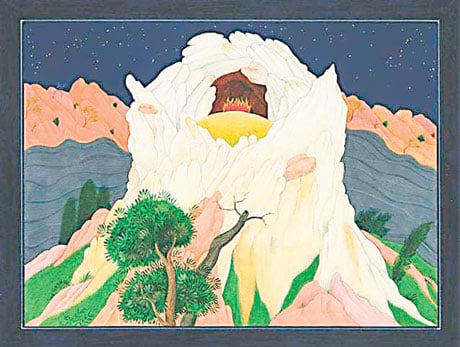Recently, an interesting exhibition took place in the Koel Gallery, Karachi. You! takes a look...
exhibition
Recently, an interesting exhibition took place in the Koel Gallery, Karachi. You! takes a look...
Art is not just about drawing and paintings. Art is made special when the artist puts his or her life experiences, and thoughts and perception on to paper. This includes one’s childhood, things one feels strongly about, as well as the different places of the world one has travelled to. One such artist is Murad Khan Mumtaz who recently, held an exhibition at the Koel Gallery, Karachi titled ‘West’. The artist gave life to his travels of the West by recreating it through art. Read on to find out more...
The artist
Murad Khan Mumtaz is a Pakistani artist trained in the traditional art of Indian miniature painting. He has also learnt techniques of Pahari painting, including the preparation of traditional natural pigments. His work mainly focuses on traditional culture that is fast diminishing from our society.
A native of Lahore, Mumtaz was educated at Pakistan’s National College of Arts and Columbia University in New York City, which he attended on a Fulbright fellowship. His work has been exhibited internationally, including recent solo presentations at Tracy Williams, Ltd. in New York and La Caja Blanca in Palma de Mallorca, Spain. He recently completed his second artist residency at the Santa Fe Art Institute.
Also an accomplished teacher, Mumtaz has taught at institutions including the National College of Arts, Beaconhouse, National University, Punjab University and the College of Traditional Islamic Art in Amman, Jordan.
Not only this, he is a co-founder of the Hast-o-Neest Centre for Traditional Art and Culture in Lahore and has published numerous articles on the history of miniature painting. He is currently doing his PhD in South Asian art history at the University of Virginia.
The exhibition
Moving on to the exhibit titled ‘West’, Mumtaz who has been travelling to the US since the past eight years decided to share his perspective on that part of the world, but in a unique way. And what better way to express yourself but through art?
In this particular exhibition, the artist’s main focus was to give the audience a glimpse into the lives of the Native Americans. In the United States, Native Americans are considered to be people whose pre-Columbian ancestors were indigenous to the lands within the nation’s modern boundaries. The natives had numerous distinct tribes, bands, and ethnic groups, and many of these groups exist till today. According to history, Native Americans descended from prehistoric hunters who walked from northeast Asia across a land bridge, formed at the end of the Ice Age, to Alaska some 12,000 years ago.
To create the paintings, Mumtaz has used the medium of opaque watercolour and natural medium on wasli, print, and multi-plate etching with hand colouring. All the work produced, whether landscape or a life form, depicted the independent way of life of the Native American people of North America. The paintings also pay homage to the lost world of pre-modern America and the West that existed before the settler invasions destroyed the old ways and before the Native Americans were eradicated with genocide. According to the artist, upon his visit to these areas, he found this landscape truly beautiful and felt that art could be created simply by recreating those landscapes.
Some of the work displayed included the landscape pieces titled ‘Crazy Men in Summer Night’, ‘Bear Lodge’ and ‘Jalwa: Day’. These works used symmetry to give reality to the scenarios and to portray the elements used in depth. On the other hand his works titled ‘Winter’, ‘Summer’, ‘Holy Well’, ‘Kiva’ and ‘Revelation’ were symbolic and served as a pleasant respite among his other skilfully rendered works. The motifs depicted in these paintings were sacred to the Native Americans.
The colours of Mumtaz’s paintings were unusual because the artist opted to compose and paint in the Pahari technique which employed flatter, brighter colours with a more simplified rendering. The exhibition surely served as a breath of fresh air for art lovers!